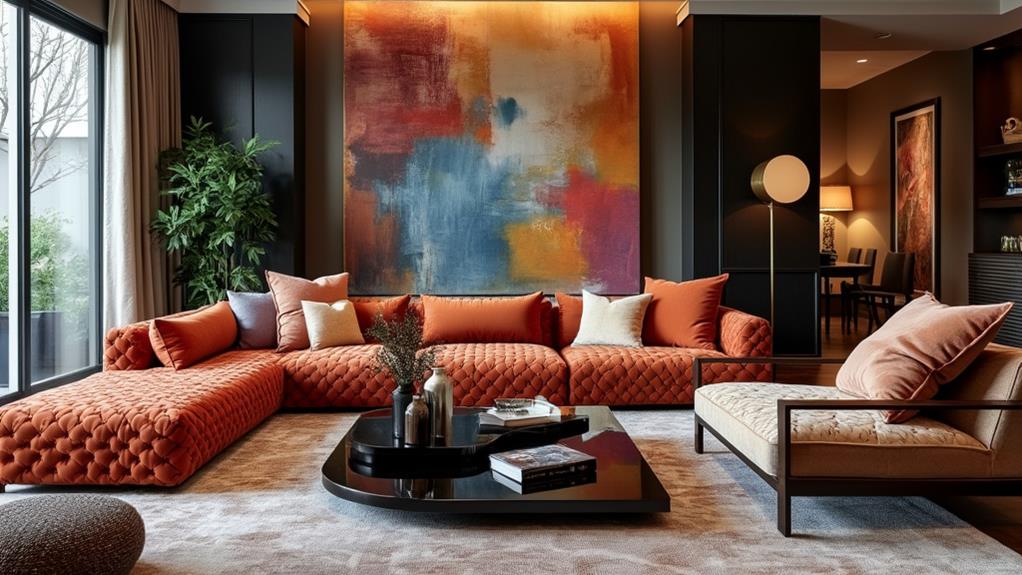In revolutionizing upholstery, we're seeing a transformation in texture, durability, and style that reshapes interior spaces. The tactile element of textures, from smooth to nubby, impacts both comfort and visual appeal, playing a key role in high-traffic areas by masking wear. Durability is assessed through fiber types and weaving techniques; synthetic blends often outshine natural fibers in resilience tests. Innovations such as stain-resistant and eco-friendly fabrics are pushing boundaries, while smart textiles introduce advanced functionality. With these developments, upholstery not only enhances aesthetics but also embodies technological progress, suggesting there's much more to uncover in this ever-evolving field.
Table of Contents
ToggleExploring Upholstery Textiles
When we explore the world of upholstery textiles, we're diving into a domain where comfort meets style head-on.
Upholstery textiles, including both fabrics and leather, play an essential role in enhancing the aesthetic appeal and comfort of our living spaces. They serve not only to pad and cover furniture but also influence the style and longevity of our interiors.
From intricate weaves to innovative treatments, these textiles offer a wide array of options that cater to personal taste and functionality. Selecting the right textile involves balancing durability with aesthetic preferences, creating a harmonious environment that reflects our lifestyle.
Additionally, regular maintenance, such as adhering to manufacturer cleaning guidelines, helps preserve the fabric's appearance and extends its life.
The Role of Texture
Texture's influence on upholstery is profound, shaping not only the comfort but also the ambiance of our spaces. It determines the tactile experience we encounter daily, impacting both our physical comfort and emotional connection to furniture.
Smooth textures often evoke a sense of sleekness and modernity, while nubby textures add warmth and coziness. Textured fabrics are particularly adept at concealing wear and tear, which makes them ideal for high-traffic areas in our homes.
Designers leverage texture creatively, blending patterns and colors to create unique, inviting environments. By incorporating various textures, we can enhance the visual and tactile appeal of our furniture, fostering a sense of ownership and attachment.
Texture is essential, not just aesthetically, but functionally, too.
Evaluating Fabric Durability
While texture greatly enhances the aesthetic and tactile appeal of upholstery, durability guarantees that these qualities endure over time.
We need to evaluate fabric durability by considering factors like fiber types, weave, and protective finishes. Natural fibers such as cotton and linen offer comfort but might lack the resilience of synthetic options like polyester and nylon, which often resist wear better.
The double rub test provides a standard measure of durability, indicating how well a fabric withstands abrasion. Higher double rub counts suggest a fabric is more suitable for high-traffic areas.
Tight weaves contribute to durability, while protective finishes enhance stain resistance. By selecting fabrics with these attributes, we ascertain our upholstery remains beautiful and functional for years to come.
Maintenance and Care Tips
Although selecting the right upholstery fabric is essential, maintaining it properly is just as important to guarantee its longevity and appeal.
We should start by regularly vacuuming our furniture to remove dust and debris, which can cause wear over time. Spot cleaning stains promptly with appropriate cleaning agents is vital, as it prevents permanent damage. For most fabrics, blotting instead of rubbing is recommended to avoid fabric distortion.
Additionally, rotating cushions can help distribute wear evenly, maintaining a uniform appearance. It's wise to keep furniture away from direct sunlight, which can fade colors and weaken fibers.
Following manufacturer guidelines for specific cleaning methods and using protective treatments enhances durability. By incorporating these practices, we make certain our upholstery remains both beautiful and functional for years.
Innovations in Upholstery
Keeping our upholstery in top shape is just the beginning of enjoying our furniture. Innovations in upholstery are transforming how we experience comfort and style.
Technological advancements have led to fabrics that resist stains, repel liquids, and maintain vibrant colors, even in high-traffic areas. We've seen eco-friendly materials gaining traction, as consumers become more environmentally conscious. Sustainable textiles minimize ecological impact without sacrificing quality or aesthetic appeal.
Designers are experimenting with bold patterns and rich textures, creating visually stunning and durable products. Additionally, smart textiles, embedded with sensors, are on the horizon, promising to enhance functionality by adjusting to our needs.
As innovation drives the industry forward, our furniture becomes not only a style statement but also a representation of technological progress.
Safety and Standards
Many of us prioritize comfort and style when selecting upholstery, but safety and standards should be at the forefront of our considerations too.
Upholstery materials must meet stringent safety standards, particularly concerning flame retardancy. Flame-retardant textiles are essential, reducing fire risks by resisting ignition and providing critical escape time during a fire.
Manufacturers apply flame-retardant treatments at various production stages to guarantee effectiveness without compromising aesthetic appeal. Compliance with regulations, such as the California Technical Bulletin 117, guarantees upholstery fabrics meet safety benchmarks.
We should also consider chemical safety; some treatments might release volatile organic compounds (VOCs), affecting indoor air quality.
Future Trends in Upholstery
As we look to the future of upholstery, innovative trends are reshaping our choices with a mix of style, technology, and sustainability.
We're seeing a surge in eco-friendly materials, driven by consumer awareness and demand for sustainable living options. These materials, sourced responsibly, reduce environmental impact while maintaining high aesthetic standards.
Technology also plays an essential role, with advancements in smart fabrics that offer stain resistance and enhanced durability. These fabrics make maintenance easier, ensuring longevity without sacrificing style.
Additionally, the integration of personalization options allows consumers to tailor upholstery to their specific tastes, reflecting individual preferences.
Collaborations between designers and manufacturers push the boundaries of creativity, resulting in unique patterns and textures that redefine modern upholstery aesthetics.


